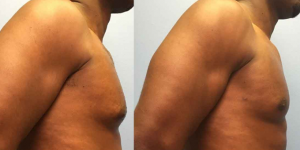(ThyBlackMan.com) More commonly known as “man boobs,” gynecomastia is a condition that’s sex-specific to biological males. It’s a physiological condition typically associated with larger-than-normal breast sizes in men or boys.
Although it’s typically a harmless situation, gynecomastia can be a cause of embarrassment for people who suffer from it. The embarrassment often arises as a result of social stigma associated with the irregular appearance of the chest of people who have the condition. More importantly, the embarrassment can lead to more complex psychological conditions, including low self-esteem and feelings of insecurity, among others. However, in some instances, gynecomastia can be a sign of more severe health conditions like liver disease, kidney failure, or even cancer. If you have any concerns, you can visit a Gynecomastia Clinic Korea or elsewhere for more information regarding potential causes and treatment options.
The common symptoms a person with the condition can expect to notice are swellings around the chest region associated with pain and tenderness. Although it isn’t very common, some people might also notice the production of nipple discharge similar to lactation. The condition can present itself in one or both breasts of a person. Such conditions can be effectively treated with the help of a skilled plastic surgeon who specializes in male chest contouring or Gynecomastia in Beverly Hills (or similar experts elsewhere), offering long-term relief from physical discomfort and emotional distress.
The condition isn’t typically associated with breast cancer. Still, you should consult a physician once you notice it, especially if there’s pain associated with it.
Causes of Gynecomastia
Most cases of gynecomastia point to a common culprit – hormonal imbalance. Estrogen and testosterone are two essential hormones in humans. For most biological males, testosterone production is much higher than that of estrogen, with the reverse being the case in most biological females. Estrogen is responsible for the development of certain “woman-like” features in females, including the growth of breast tissue. However, due to the presence of higher levels of testosterone in biological males, the effects of estrogen are limited.
Certain conditions can, however, trigger either a reduction of testosterone production in biological males or an increase in the production of estrogen, resulting in the unbalancing of the body’s hormones. The most visible effect of this hormonal imbalance is the condition of gynecomastia.
Although hormonal imbalance is the primary culprit, several risk factors predispose people to gynecomastia. Here are some of the most common predisposing conditions:
- Age: Since gynecomastia is caused by hormonal imbalance, every time the body undergoes hormonal changes, there’s a risk of experiencing the condition. Three major age brackets have a high risk of gynecomastia – newly born baby boys, boys experiencing puberty, and aging men. Newly born baby boys run the risk of having gynecomastia because the placenta that attaches them to their mother carries estrogen to them. The condition, however, should disappear after a few weeks as the body begins to balance hormone production. Puberty is a very challenging period for most teenage boys as their hormones are in constant flux. It isn’t unusual during adolescence for a boy’s testosterone levels to drop. The resulting increase in estrogen activity can result in an increase in the size of the breast tissue. In most cases, the breast size will come back to normal as the boy ages and the hormone levels gain stability. Older men, on the other hand, tend to naturally produce lower levels of testosterone while accumulating more body fat, which can result in excess breast tissue growth.
- Obesity: Being overweight has been proven to have a direct effect on increasing estrogen production in the body. The increased production of estrogen, combined with the presence of extra fat tissue, often results in the formation of excess tissue around the breast.
- Medications: Certain medications that affect the production of hormones in a person can also cause gynecomastia as a side effect. A typical example of this is an anti-androgen drug that’s used to treat prostate conditions like prostate cancer and enlarged prostates, among others. The prostate is part of the male body responsible for testosterone production. Drugs that influence the prostate are likely to affect testosterone production and cause gynecomastia. Other classes of drugs that can cause gynecomastia are anabolic steroids, AIDS medication, anti-anxiety medication, antibiotics, tricyclic antidepressants, cancer treatment, and ulcer medication.
- Alcohol and illegal drugs: The constant use of alcohol, amphetamines, methadone, cannabis, marijuana, and heroin are also well-known risk factors for developing the condition.
- Health conditions: Multiple health conditions can be risk factors for gynecomastia, including hypogonadism, hyperthyroidism, kidney failure, tumors, liver failure, or cirrhosis.
How to Deal With Gynecomastia
While gynecomastia may be a psychologically challenging condition to live with, it typically resolves itself without any complications. However, for people who are unwilling to wait for the body to naturally return to balance, there are several options available for managing it.
- Compression outfits: While compression shirts aren’t a curative measure for dealing with gynecomastia, they can be very effective in masking the condition, especially when it isn’t well-pronounced. As highlighted earlier, the most common challenge people with gynecomastia face is psychological due to embarrassment from the unusual appearance. Compression outfits are typically made to be comfortably tight on the skin, therefore removing the appearance of a bulge on the user’s chest. You can search for gynecomastia nipple covers or compression shirts to find undershirts that can help provide a confidence boost.
- Working out: For people with naturally occurring gynecomastia, hitting the gym might be an excellent solution. It’s also recommended for people whose condition is caused by obesity. Losing excess weight might do the trick for you, and you get to be fit, too.
- Medication: If you’re not willing to wait it out, some medicines can be prescribed by your physician to manage the condition. The function of these drugs typically involves adjusting your body’s hormonal balance.
- Surgery: Surgery isn’t typically required for dealing with gynecomastia unless it’s life-threatening, which it rarely is. It’s not advisable to surgically remove the excess fat unless there’s significant discomfort associated with the condition, or it isn’t responding to other forms of treatment. However, it’s an option open to anyone willing to pay for the procedure.
Staff Writer; Ronald Shaw

















Leave a Reply